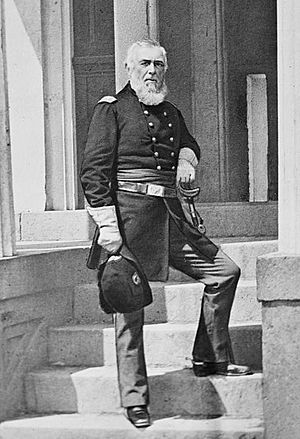Dixon Stansbury Miles facts for kids
Quick facts for kids
Dixon Stansbury Miles
|
|
|---|---|

Col. Miles at Harper's Ferry, VA
|
|
| Born | May 4, 1804 Maryland, U.S. |
| Died | September 16, 1862 (aged 58) Harper's Ferry, Virginia |
| Place of burial | |
| Allegiance | United States of America |
| Service/ |
United States Army |
| Years of service | 1824–1862 |
| Rank | |
| Unit | 4th U.S. Infantry Regiment 7th U.S. Infantry Regiment 5th U.S. Infantry Regiment |
| Commands held | 2nd U.S. Infantry Regiment 5th Division, Army of Northeastern Virginia Railroad Brigade Post of Harper's Ferry |
| Battles/wars | American Indian Wars |
Dixon Stansbury Miles (born May 4, 1804 – died September 16, 1862) was an officer in the United States Army. He served in several wars, including the Mexican–American War and the American Indian Wars. He was badly wounded while surrendering his soldiers during the Battle of Harpers Ferry in the American Civil War.
Contents
Early Life and Military Career
Miles was born in Maryland. He went to the United States Military Academy at West Point. He graduated in 1824. He became a second lieutenant in the 4th U.S. Infantry. Soon after, he moved to the 7th U.S. Infantry Regiment. He served with this group until 1847.
He spent time on the western frontier. He became an adjutant, helping the commander of the 7th U.S. He was promoted to captain in 1836. From 1839 to 1842, he fought in the Seminole Wars in Florida.
Fighting in the Mexican-American War
When the Mexican–American War began, Miles was promoted to major. This was for his brave actions defending Fort Brown in Texas. He also fought in the Battle of Monterrey. Later, he was part of the Siege of Veracruz. After the siege, he was in charge of Veracruz for four months. He was promoted again to lieutenant colonel for his courage in the battles at Monterrey.
Before the Civil War, Miles continued to serve on the frontier. He fought against Native Americans. In 1857, he fought along the Gila River in New Mexico. In 1858, he fought against the Navajo. In 1859, he became a Colonel. He commanded the 2nd U.S. Infantry Regiment. This unit was stationed at Fort Kearny and Fort Leavenworth.
Civil War Service
When the American Civil War started, Colonel Miles was called to Washington, D.C.. For a short time, he led a group of soldiers under Major General Robert Patterson. Then, he was moved to the army of Brigadier General Irvin McDowell. Here, he commanded a larger group of two brigades.
During the First Battle of Bull Run, his soldiers were held in reserve. After this battle, he faced some criticism. He then took an eight-month break from duty. In March 1862, he was given command of a group defending the Baltimore and Ohio Railroad. In September 1862, he was put in charge of the U.S. arsenal at Harpers Ferry.
The Battle of Harpers Ferry
During the Maryland Campaign, Confederate General Robert E. Lee moved his army into Maryland. Colonel Miles's soldiers at Harpers Ferry were right on Lee's supply route. Miles was ordered to hold the important U.S. arsenal and railroad bridges. He was told to wait for help from Union forces under Major General George B. McClellan.
General Lee sent his soldiers from three directions to surround Harpers Ferry. Miles made a mistake in how he defended the town. He placed most of his 14,000 men just outside the town on Bolivar Heights. He did not put enough soldiers on the important high ground nearby. These were Maryland Heights to the northeast and Loudoun Heights to the south.
When his small group on Maryland Heights was defeated, the town was surrounded. It became very hard to defend. On September 15, 1862, Confederate Major General Stonewall Jackson began to attack the town with cannons from the heights he had taken. Miles met with his commanders and decided to surrender. Before the white flag could be raised, he was hit in the leg by an exploding shell. He was badly wounded and died the next day.
Colonel Miles is buried in St. James Episcopal Church Cemetery in Monkton, Maryland.
Legacy and Impact
The surrender of 12,419 Union soldiers at Harpers Ferry was a very large surrender. It was the biggest surrender of U.S. soldiers until World War II. A military investigation looked into the surrender.

